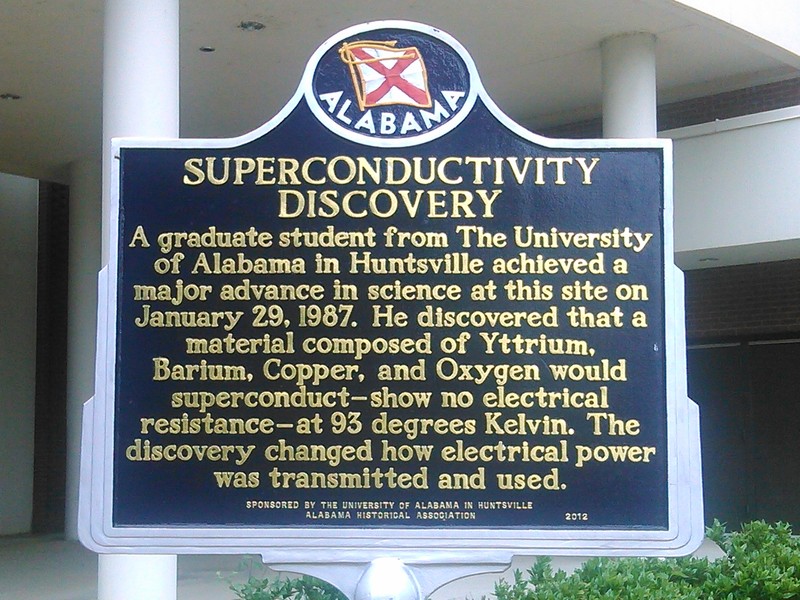Superconductivity Historic Marker
Introduction
Text-to-speech Audio
The historic marker located outside of Wilson Hall details the 1987 creation of a superconductor that retained it's properties over the 77° Kelvin threshold, where cooling becomes more efficient and, in many cases cheaper. The material was discovered under Dr. Wu of The University of Alabama in Huntsville's guidance, by graduate students, and verified by Dr. Chu of the University of Houston. It is one of many scientific discoveries over the years made on the UAH campus, by UAH students, staff, and faculty. This breakthrough was achieved at a laboratory in what is now called Wilson Hall, then known as the Science and Engineering building.
Images
Superconductivity Discovery Marker

Backstory and Context
Text-to-speech Audio
In 1987, we were already aware of superconductivity - that is, the conduction of electricity with no or negligible resistance. Researchers had achieved it at very low temperatures below about 77° Kelvin, in some cases approaching absolute zero, but the issue that arose was the inefficient ways we had of cooling it, namely liquid helium. To cool it more efficiently and more affordably, the temperature at which a material superconducts would have to be over 77° Kelvin so that liquid nitrogen could be used instead. The first discovery of such a material was at The University of Alabama in Huntsville.
Dr. Wu of the University of Alabama in Huntsville and Dr. Chu of the University of Houston observed this in an experiment conducted on January 29th of 1987 using an alloy composed of Yttrium, Barium, Copper, and Oxygen. Working under Dr. Wu at UAH were graduate students James Ashburn and C.J. Torng. The team produced a superconductor that worked at temperatures as high as 95° Kelvin (later observed at 98° Kelvin in a different laboratory), which was previously unheard of. This team was noticed by not only UAH's local community in Huntsville, but also by national news agencies, including positions on the front pages of The New York Times and The Atlanta Constitution, as well as being covered on the Cable News Network (CNN). It was such a significant achievement that it also attracted further funding for UAH's research in various other fields.
On the 8th of June in 1987, it was reported that UAH received a grant totaling $120,000 for superconductivity and laser optics research from the state of Alabama, as a result of the discovery made on the campus. Governor Hunt stated in regards to the grant:
The potential scientific and commercial benefits of this discovery are limitless. This type of breakthrough means national prestige, a sharpening of Alabama's competitive edge, and an important boost to the state's economy.[1]
UAH would receive and additional $160,000 from NASA to continue research in this field as this discovery could have a significant impact on their efforts as well. This specific scientific discovery that occurred in a UAH lab was globally important, as it ultimately would allow for several real world applications of superconductors that we still use today, including, but not limited to "levitated trains, power generators and transmission lines without resistive losses and very large magnets for medical magnetic resonance imaging."[2]
It was a significant breakthrough in three quarters of a century's work on superconductivity and had a lasting effect not only on UAH's ability to receive grants and other funding but also on the larger scientific community. To honor and to document this history, a historic marker was installed outside of Wilson Hall, then called the Science and Engineering Building, that provides information for this significant breakthrough and gives credit to the graduate student who first observed the spectacular temperature.
Sources
“Announcement Regarding UAH's Breakthrough in Superconductivity,” Box 15, Folder 20, Charles Lundquist Collection, The UAH Archives and Special Collections
Thornton, Melissa F.. "Three Quarters of a Century Science Goal Surpassed at UAH." The University of Alabama in Huntsville News Release (Huntsville) February 16th 1987.
[2] Thornton, Melissa Ford. "Dr. Wu: "We've Hit the Jackpot"." Postscripts (Huntsville) February 25th 1987. 6 ed, 4 sec, 1-2.
[1] The University of Alabama in Huntsville. "UAH Receives First-Of-A-Kind State Grant." Postscripts (Huntsville) June 8th 1987. 6 ed, 15 sec, 1-3.
The University of Alabama in Huntsville. "NASA Funds Additional UAH Superconductivity Research." Postscripts (Huntsville) August 17th 1987. 6 ed, 20 sec.2.
The University of Alabama in Huntsville. "What Is Superconductivity?." Postscripts (Huntsville) February 25th 1987. 6 ed, 4 sec.2.
Lee Hattabaugh, "Superconductivity Discovery Marker," The Historical Marker Database, accessed July 7th, 2022, https://www.hmdb.org/m.asp?m=94963
